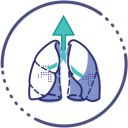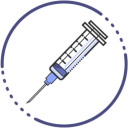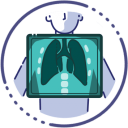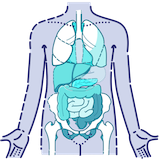The following guidelines are treatment recommendations for managing CF in the first 2 years of life and are intended to help guide healthcare professionals and CF center staff members.¹
During routine appointments, a caregiver can anticipate their loved one may undergo certain procedures, tests, and scans, like below¹:

Airway clearance techniques1,2
Assists with moving mucus away from the lungs, which may reduce infection and improve lung function
Assists with moving mucus away from the lungs, which may reduce infection and improve lung function
Assists with moving mucus away from the lungs, which may reduce infection and improve lung function

Routine vaccinations¹
- The American Academy of Pediatrics recommends that all standard vaccinations apply for individuals with CF
- Annual influenza vaccine is recommended for all infants over 6 months of age with CF and their household members
- The American Academy of Pediatrics recommends that all standard vaccinations apply for individuals with CF
- Annual influenza vaccine is recommended for all infants over 6 months of age with CF and their household members
- The American Academy of Pediatrics recommends that all standard vaccinations apply for individuals with CF
- Annual influenza vaccine is recommended for all infants over 6 months of age with CF and their household members

Oropharyngeal cultures¹
Routine surveillance of respiratory microbiology is necessary, including eradication regimens, regardless of presence or absence of symptoms

Lung clearance index (LCI)³
Lung clearance index (LCI)³
Lung clearance index (LCI)³
LCI is a sensitive measure of overall ventilation inhomogeneity assessed by multiple-breath washout that is based on tidal breathing techniques

Chest X-rays¹
Used to detect early abnormalities, including hyperinflation, peribronchial cuffing, or streakiness
Used to detect early abnormalities, including hyperinflation, peribronchial cuffing, or streakiness
Used to detect early abnormalities, including hyperinflation, peribronchial cuffing, or streakiness
Monitoring and Care for Infants With CF Up to Age 2¹
The table below provides an overview of CF care recommendations and considerations up to age 2.
| AGE AT VISIT | day of sweat test | 24-48 hours of dx |
1 wk later or age 1 mo |
2 MOa | 3 MOa | 4 MOa | 5 MOa | 6 mob | 8 mob | 10 mob | 1 yr | every 2-3 mo. in the 2nd yr of life | 2 yr |
|---|---|---|---|---|---|---|---|---|---|---|---|---|---|
| care issues | |||||||||||||
| Discuss diagnosis | Either visit | ||||||||||||
| Encourage human milk feeding |
Either visit | ||||||||||||
| Start PERTc | Either visit | ||||||||||||
| Start salt supplementation | 1/8 tsp. salt | 1/4 tsp. salt | |||||||||||
| Start vitamins designed for CF patients |
Either visit | ||||||||||||
| History and physical with weight, length, OFC |
Either visit | ||||||||||||
| Teach / initiate P&PD | |||||||||||||
| Assess weight gain, caloric intake and PERT dose | |||||||||||||
| Diagnostic testing | |||||||||||||
| Sweat test | All 1° sibs | ||||||||||||
| Pancreatic functional status testingᶠ | At one of these visits |
||||||||||||
| Respiratory cultureᵍ | |||||||||||||
| Chest X-ray | At one of these visits | ||||||||||||
| Vitamin levels A, D, Eh | At one of these visits | ||||||||||||
| Serum electrolytes, BUN, creatinine | |||||||||||||
| Complete blood count | |||||||||||||
| AST/ALT/GGT/bili, albumin, ALP | |||||||||||||
| education | |||||||||||||
| Infection Control | |||||||||||||
| Fill out “Who to call–where to go” sheet | Either visit | ||||||||||||
| CFF Patient Registry consent |
Either visit | ||||||||||||
| Discuss clinical research | |||||||||||||
| Feeding Behavior Anticipatory Guidance | Either visit | Either visit | At 2 of these visits | ||||||||||
| Referrals to community food resources | |||||||||||||
| Review ACT technique | |||||||||||||
| Tobacco smoke exposure avoidance education | |||||||||||||
| Genetic counseling | At one of these visits | ||||||||||||
| DATE DONE | |||||||||||||
aIn some circumstances, care may be shared with a primary care physician; infants growing poorly may need to be seen more often; some stable infants can be seen every 6 weeks.
bSome centers may plan additional routine visits at 7, 9, and 11 months.
cStart PERT if patient has symptoms, fecal elastase <200 mcg/g, coefficient of fat absorption <85%, or 2 CFTR mutations associated with pancreatic insufficiency.
dMany centers include oximetry; pulse oximetry should be performed in infants with acute respiratory symptoms.
eRoutine immunizations should be given by the primary care provider; Palivizumab may be given in appropriate season; influenza vaccine should be given in the appropriate season after 6 months of age.
fRecheck a measure of pancreatic phenotype, such as fecal elastase, if patients have weight loss or GI symptoms.
gRespiratory cultures may be performed more frequently if patient has symptoms.
hVitamin levels are optimally checked 1 to 2 months after starting supplements; ensure that fluoride intake is adequate or is supplemented.
Conversation Considerations for Caregivers
Conversation Considerations for Caregivers
Conversation Considerations
for Caregivers
It can be beneficial to explain to a caregiver the nutritional needs of a child with CF because appropriate development and weight gain may benefit a child with their lung function.¹ The following discussion points are provided as examples.
You may want to discuss:



Click here for additional care considerations based on age.
Ultimately, careful monitoring and medical intervention from an early age will encourage better outcomes for a child with CF.¹
Ultimately, careful monitoring and medical intervention from an early age will encourage better outcomes for a child with CF.¹
Ultimately, careful monitoring and medical intervention from an early age will encourage better outcomes for a child with CF.¹
ACT, airway clearance therapy; ALP, alkaline phosphatase; ALT, alanine aminotransferase; AST, aspartate aminotransferase; bili, bilirubin; BUN, blood urea nitrogen; CFF, cystic fibrosis foundation; CFTR, cystic fibrosis transmembrane conductance regulator; Dx, diagnosis; GGT, gamma-glutamyl transferase; GI, gastrointestinal; MO, month; OFC, occipitofrontal circumference; PERT, pancreatic enzyme replacement therapy; P&PD, percussion and postural drainage; WK, week; YR, year.
ACT, airway clearance therapy; ALP, alkaline phosphatase; ALT, alanine aminotransferase; AST, aspartate aminotransferase; bili, bilirubin; BUN, blood urea nitrogen; CFF, cystic fibrosis foundation; CFTR, cystic fibrosis transmembrane conductance regulator; Dx, diagnosis; GGT, gamma-glutamyl transferase; GI, gastrointestinal; MO, month; OFC, occipitofrontal circumference; PERT, pancreatic enzyme replacement therapy; P&PD, percussion and postural drainage; WK, week; YR, year.
ACT, airway clearance therapy; ALP, alkaline phosphatase; ALT, alanine aminotransferase; AST, aspartate aminotransferase; bili, bilirubin; BUN, blood urea nitrogen; CFF, cystic fibrosis foundation; CFTR, cystic fibrosis transmembrane conductance regulator; Dx, diagnosis; GGT, gamma-glutamyl transferase; GI, gastrointestinal; MO, month; OFC, occipitofrontal circumference; PERT, pancreatic enzyme replacement therapy; P&PD, percussion and postural drainage; WK, week; YR, year.
You May Also Be Interested In
References: 1. Borowitz D, Robinson KA, Rosenfeld M, et al. Cystic Fibrosis Foundation evidence-based guidelines for management of infants with cystic fibrosis. J Pediatr. 2009;155(suppl 6):S73-93. doi:10.1016/j.jpeds.2009.09.001 2. Airway Clearance. Cystic Fibrosis Foundation. Accessed June 22, 2023. https://www.cff.org/Life-With-CF/Treatments-and-Therapies/Airway-Clearance/ 3. Gustafsson PM, De Jong PA, Tiddens HA, Lindblad A. Multiple-breath inert gas washout and spirometry versus structural lung disease in cystic fibrosis. Thorax. 2008;63(2):129-134. doi:10.1136/thx.2007.077784



